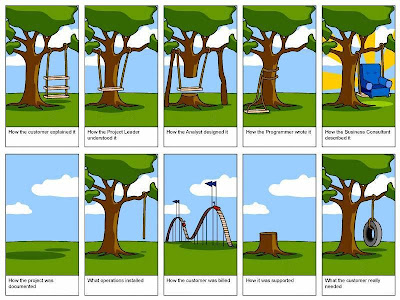
Traditional project management involves very disciplined and deliberate planning and control methods. With this approach, distinct project life cycle phases are easily recognisable. Tasks are completed one after another in an orderly sequence, requiring a significant part of the project to be planned up front. For example, in a construction project, the team needs to determine requirements, design and plan for the entire building, and not just incremental components, in order to understand the full scope of the effort.
Traditional project management assumes that events affecting the project are predictable and that tools and activities are well understood. In addition, with traditional project management, once a phase is complete, it is assumed that it will not be revisited. The strengths of this approach are that it lays out the steps for development and stresses the importance of requirements. The limitations are that projects rarely follow the sequential flow, and clients usually find it difficult to completely state all requirements early in the project.
Today, business processes are more complex and interconnected than ever before. Additionally, they reject traditional organisational structures and involve complex communities comprised of alliances with strategic suppliers, outsourcing vendors, networks of customers, partnerships and even competitors. Through these alliances, organisations are able to address the pressures of unprecedented change, global competition, time-to-market compression, rapidly changing technologies and increasing complexity at every turn. Because of this multifaceted nature of businesses, projects that implement new business systems are also more complex.
For years, economists have been warning that success in a global marketplace is contingent upon the capability to produce small batches of tailored products on a tight schedule to meet growing demands in emerging markets.
Improving these performance records is a goal for any organisation. However, if traditional project management is somewhat ineffective, it's time to examine other methods of designing and delivering projects.
Agile project management:
For projects involving a significant software component, traditional project management can be somewhat ineffective since the requirements are elusive, volatile and subject to change. An alternative approach, Agile Project Management (APM), is emerging in the industry. APM is a highly iterative and incremental process, where developers and project stakeholders actively work together to understand the domain, identify what needs to be built, and prioritise functionality.
Agile methods are used when these conditions are present: project value is clear; the customer actively participates throughout the project; the customer, designers, and dev elopers are co-located; incremental feature-driven development is possible; and visual documentation (cards on the wall vs. formal documentation) is acceptable.
elopers are co-located; incremental feature-driven development is possible; and visual documentation (cards on the wall vs. formal documentation) is acceptable.
The Agile approach consists of many rapid iterative planning and development cycles, allowing a project team to constantly evaluate the evolving product and obtain immediate feedback from users or stakeholders. The team learns and improves the product, as well as their working methods, from each successive cycle. After a streamlined planning, requirements definition and solution design phase is completed to get the project underway, iterations of more detailed planning, requirements, design, build and test take place in waves. This approach allows for immediate modifications of the product as requirements come into view. APM requires a dedicated full-time project team that includes a customer or end user, where team members work from the same location.
The agile project management environment:
APM development is conducted collaboratively, with a small co-located team. This core team usually consists of two developers who write code in pairs (for quality control), the customer/end-user, IT architect(s), a business analyst and a project manager. The work is accomplished through a series of sessions where the team writes code, then tests working modules of the system and repeats the process. There is minimal documentation as the team relies almost exclusively on informal internal communication.
Again, this differs from the traditional approach where a considerable amount of time is invested in planning and a significant amount of requirements documentation is produced. The Agile team identifies and prioritises the features based on business value, and after high-risk components of the system are produced, works on the highest value features first. This approach works if the solution can be delivered incrementally to the customer. If this is not possible, features still can be built incrementally and then integrated into the first release of the system.
Agile management components:
There are several key elements that provide the basis for APM. These techniques can also be used in traditional software development methods to improve project performance.
They are:
- Visual control:This is a "cards-on-the-wall" method of planning to assist a team in organising the work of the project. For example, one successful Agile project team placed different colour groups of cards that represented the features of the solution on the wall. The features that were designed, developed, tested and in production were one colour, the features that were designed, built, tested but not yet put in production (but ready to go) were another colour. The team was able to see at a glance where they were with each feature set. Visual control ensures that every member of the team views the project the same way.
- Co-located high performing team: In Agile development, all the key team members are co-located, including the customer/end-user, preferably in a work room. This approach greatly increases the quality of co-ordination and communication. However, this may represent a significant cultural change for IT developers. Since project managers are responsible for building a high performing team, they need to ensure that they have been assigned developers who truly can work in this collaborative manner.

- Test driven development: In cases when the customer is having a difficult time articulating requirements, Agile teams often use test-driven development. This requires more iteration between requirements, design, development and test. Agile teams almost always develop test plans at the same time they define requirements; if a requirement isn't testable, then it is not yet fully developed. This is a best practice that can be used in traditional development to ensure requirements are complete, accurate and testable.
- Adaptive control: Everyone on the team is constantly adapting. Because of this dynamic environment, the project manager needs to be seen as a leader, not a taskmaster. Instead of setting rigid instructions for the team to follow, the project manager facilitates the team in establishing working relationships, setting ground rules and fostering collaboration. Agile team members continuously adapt to improve their methods as they incorporate lessons learned from the previous cycle into the next iteration, also a best practice for any project
- Collaborative development: APM relies on collaboration among all team members to deliver results, capture candid feedback and implement learning's on the next iteration of the solution. This is one of the strengths of APM constant feedback and improvement. The project manager completes the initial planning and the business analyst defines and prioritises the solution features in collaboration with the customer and technology representatives. Then the Agile project teams collaborate on the design, development, testing and reworking of each incremental build. It is this constant collaboration with the customer that promotes project success.
- Feature driven development: This practice greatly reduces complexity and allows the team to focus on one feature at a time. For example, one team is working on Feature #4 and that's the team's only focus. They don't concern themselves about Features #1-3. It is the business analyst and project manager who ensure the next feature in the backlog is truly the next priority, based on business value and risk. Typically, high-risk components or core infrastructure pieces are built first, and then everything else is prioritised based on business value. The goal is to build the feature-driven components with only a one-way dependency to the core system; therefore, specialised components are independent of each other and can be created in any order or even in parallel.
- Leadership and collaboration rather than command and control: "The principles of APM are timeless and links closely to leadership. It addresses a lot of the steps that facilitate leadership much more than traditional management," says Sanjiv Augustine, Managing Director of the Lean-Agile Consulting Practice at CC Pace Systems in Fairfax, VA. The project manager works with the client management, the IT management and the key stakeholders to ensure they know the project's status. Additionally, the project manager removes any barriers hindering the core Agile teams.
- Lessons learned: After each cycle, the team holds a lessons learned session to determine what they can do better on the next iteration. As the team learns, it adapts how the members are working together to continuously improve team performance.
The value proposition:
"The traditional project management approach," reports, "is a linear approach where you try to get it all done at one time. We do a lot of very detailed planning at once up-front and then deliver it in what's known as the Big Bang. That industrial age thinking has spilled over from software development to other projects as well." This is the heart of the difference between Agile and traditional project management.
The Big Bang now comes from the greater flexibility and collaboration APM provides. "Just enough" planning is done up-front. As each increment of the system is built, the team gathers input and learns from customer feedback. Since the customer sees and/or experiences a working prototype, he or she is better able to refine or redefine requirements and describe to the team what the organisation really needs. The Agile method embraces changes that add value, and reduces the cost of change through iterative development. Making changes to a small module is very cost-effective, compared to designing and developing a huge system and then trying to make changes to it.
Can agile project management work?
"At its heart, project management, traditional or Agile, has very similar principles. It's about doing a good job for the customer. It's about leading a team. It's about delivering measurable business results," says Augustine. Many of these principles or practi ces can be implemented into most team-structured environments. Yet, some project management professionals may discard the principles of Agile management if they are unable to adopt all of the components and practices. This is a mistake. For example, what happens if they cannot get the user to sit full-time with the team in the workroom? It doesn't mean they can't incorporate some of the other pieces of Agile management such as visual control and feature-driven development. Besides, even if a user cannot be involved on a full-time basis, most users are willing to participate on the team, especially during the testing and feature prioritisation. The rest of the time, the business analyst can represent the user while the full time core team continues to work together.
ces can be implemented into most team-structured environments. Yet, some project management professionals may discard the principles of Agile management if they are unable to adopt all of the components and practices. This is a mistake. For example, what happens if they cannot get the user to sit full-time with the team in the workroom? It doesn't mean they can't incorporate some of the other pieces of Agile management such as visual control and feature-driven development. Besides, even if a user cannot be involved on a full-time basis, most users are willing to participate on the team, especially during the testing and feature prioritisation. The rest of the time, the business analyst can represent the user while the full time core team continues to work together.
Incorporating Agile management techniques into projects fosters a focus on the benefits of each feature. In traditional project management, the teams strive to finish the project on time and under budget and often lose sight of the overall benefits the entire effort is intended to bring the organisation. It's important to remember the strategy the project is expected to advance as well as the total cost of ownership and not just the project costs. In this way, the benefits of the project will be obvious, whether the team is constructing a building or developing a new business solution.

























